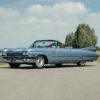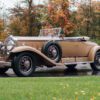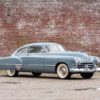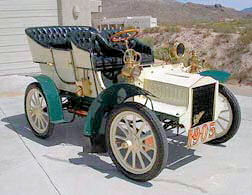Cadillac Models & History F 1905
Introducedin January, 1905 the Model F featured a new front end styling which was recognized as a desirable improvement. Not only did Cadillac update Model B’s with the Model F “hood” and radiator (Model C), but owners of A’s and B’s had the new nose grafted to their cars. There was even an aftermarket supplier of update kits. The Model F had the same chassis as Model E except for a two inch longer wheelbase. One body style was the first Cadillac one cylinder touring car with non-detachable tonneau and two side doors for tonneau entrance. Another body style was a delivery vehicle.
The Model F cost $950. Calendar year sales and production (combined with the B, C, and E models) was 4029. The model year sales were the same number.
STYLE
| Model No. | Body type | Seating | Price | Weight |
|---|---|---|---|---|
| Model F | 2-door Touring | 4 | $950 | 614 kg |
| Model F | Delivery | 2 | $950 | 636 kg |
ENGINE
|
Engine
|
Horizontal, with cylinder to the rear |
|
Cylinders
|
One |
|
Block
|
Cast iron |
|
Water jacket
|
Copper |
|
Bore & Stroke
|
127mm x 127mm |
|
Displacement
|
1.609 Liters |
|
Brake H.P.
|
“Higher than advertised or calculated H.P.” Advertised H.P.: 9 |
|
Main bearings
|
Two |
|
Valve lifters
|
mechanical |
|
Engine numbers
|
4200-5000 with BE (1904), 5000-6600 with E, 6600-8200 with CE, 8200-8350 with ACE, 13501-13706 with ACE-special, 13728-14200 |
|
Carburetor
|
Updraft mixer carburetor manufactured by Cadillac. |
CHASSIS
| Feature | Model F | Model F Delivery |
|---|---|---|
| Brake type | Mechanical | Mechanical |
| Brake wheels | two wheels | two wheels |
| Brake contraction | on inboard drums | on inboard drums |
| Wheels | 12 spoke wood wheels (14 spokes on prototype) — 23 in. | 12 spoke wood wheels (14 spokes on prototype) — 23 in. |
| Tires | 28 x 3.5 Clincher | 30 x 3.5 Clincher |
| Wheelbase | 1930mm | 1930mm |
| Overall length | 2845mm | 2845mm |
|
Height
|
1626mm | 2134mm |
| Front / Rear Tread | 1435mm | 1435mm |
| Optional Front / Rear Tread | 1549mm | |
| Weight | 613.6 kg | 636 kg |
DRIVETRAIN
|
Transmission type
|
Planetary transmission |
|
Speeds
|
Two Forward (3:1 and 1:1) and one reverse |
|
Controls
|
low — foot pedal, rev., high — lever to right. |
|
Clutch
|
Low, rev. — bands, High disc clutch |
|
Drive
|
Chain drive |
|
Differential
|
Spur gear differential with overall ratio 3.1:1 to 5:1 |
|
Overall ratio
|
3.1:1 to 5:1 (Different combinations of 9 or 10 tooth driving sprocket with 31, 34, 38, 41, or 45 tooth driven sprocket gave ten possible ratios from 3.1:1 to 5:1. Lower ratios for runabout to be run on smooth, level roads to higher ratios for loaded Delivery to be run on rough, hilly roads. Instructions for changing sprockets were furnished to owners, but the change involved disassembly of the transmission and rear axle — definitely not a “quick-change” setup. |
OPTIONS
HISTORICAL NOTES
Cadillac Notes
- After the merger with Leland and Faulconer,
- C. A. Black was the president of Cadillac
- A. E. F. White was vice-president
- Lemuel C. Bowen was Secreetary
- William H. Murphy was treasurer
- Wilfred Leland was assistant treasurer
- Henry M. Leland was general manager
- William E. Metzger was the sales manager
- Frank Johnson was chief engineer until 1914
- There were 156 units of Model D produced and 3556 units of the other models
- After designing the one cylinder and Model D Cadillacs, Alanson Brush left Leland & Faulconer/Cadillac and extracted a lump sum and royalty payments for use of his patents. This action triggered a plan to purge Cadillac design of Brush influence.
- Cadillac Automobile Co. and Leland & Faulconer merged in Oct., 1905 to form Cadillac Motor Car Co., Henry Leland became General Manager of the new company.
- Maximum production capability one car every ten minutes of each ten hour working day.
- Serial numbers were not used on any of these models. Engine numbers were stamped two places on crankcase.
- Top, right edge of cylinder flange, near water outlet.
- Right, front face, just below top cover.
- (Blank spaces on patent plate are for additional patent dates, not engine number.)
1905 Automotive Notes
- The automobile industry produced 24,250 cars and 750 trucks
- Maxwell begins production with 2-cylinder models
- Reo begins production
- The Ariel car is air-cooled in winter and water-cooled in summer
- Adams-Farwell features a 3-cylinder rotary engine
- Oldsmobile includes a 2-cylinder touring model in its lineup
- Overland leaves the single cylinder cars in favor of two- and four-cylinder models
- Packard increases its 4-cylinder engine size to produce 28 bhp
- Studebaker has a 20 bhp 4-cylinder car
- The Society of Automobile Engineers (SAE) is formed
- The American Motor Car Manufacturers Association is formed
- Top model year production for 1905
1. Oldsmobile 6500 … increased about 1000 2. Cadillac 3942 … increased 1500 3. Rambler 3807 … increased 1500 4. Ford 1599 … decreased 96 5. Franklin 1098 … increased 700 6. White 1015 … increased 300 7. Reo 864 8. Maxwell 823








